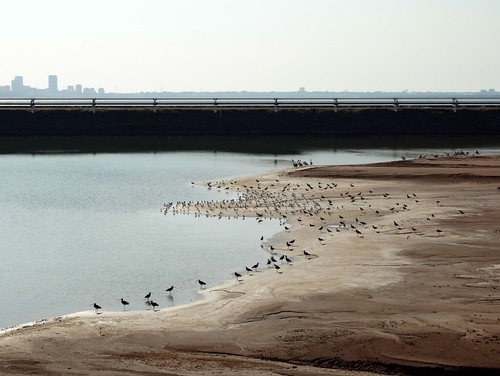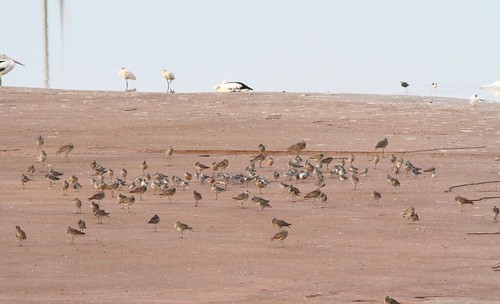by Amanda Lilleyman on Wader Quest the newsletter

Far Eastern Curlew, terns and pelicans roosting in the dredge pond at high tide © Amanda Lilleyman
The plight of waders belonging to the Numeniini tribe has been recognised across the flyways of the world, and scientists and wader lovers are desperately working to reduce further declines of these species. Most of the time, the threats to these birds seem out of the hands of those that watch waders routinely; however, the ever-useful tool of monitoring can reveal unknown trends and document new use of roost sites. While stopping the destruction of tidal flats in the Yellow Sea may not be achievable for some, monitoring of waders has helped us learn a great deal about species’ population status and regional trends. Monitoring of waders at a roost on the non-breeding grounds of Darwin, Northern Territory, Australia has revealed some new insights into the local populations of Eurasian Whimbrel Numenius phaeopus and Far Eastern Curlew Numenius madagasc ariensis.
Darwin Harbour in the Top End of Australia is a macrotidal tropical estuary with up to two thirds of the harbour’s foreshore fringed by mangroves. Supratidal saltpans back these stilted forests and provide roosting (and some foraging) habitat for waders. Eurasian Whimbrel, Grey-tailed Tattler, Terek Sandpiper and Common Sandpiper all make use of these mangrove forests for roosting, while the larger Far Eastern Curlew wait out the tide in the saltpans or move to roosts nearby. One such roost is available at all tide heights as it is an artificial pond used for dredging activities and managed by Darwin Port. Being a port site, it is restricted access to the public, thereby creating a roost with relatively few human disturbances. This site is particularly attractive to the birds and they all arrive as the incoming tide forces them out of mangrove trees and saltpans. This roost has become popular over time (7 years of monitoring) and more birds, particularly Eurasian Whimbrel and Far Eastern Curlew are exploiting the muddy ponds where they can stand in shallow water. Being close to the mudflats where these birds forage, this site provides a roost that is not overly taxing on a bird’s daily commute.

Far Eastern Curlew and one Red-capped Plover © Amanda Lilleyman
Like elsewhere in the East Asian-Australasian Flyway, the coastline of Darwin is being developed – mostly for port and mining-related activities – and this threatens the habitat available to waders. But waders, seemingly adaptable have made use of these anthropogenic developments and this port site can support over 1000 birds, and regularly attracts nationally important numbers of waders, including 0.1% of the flyway population of Eurasian Whimbrel and Far Eastern Curlew. The coastal pressures on habitat used by these birds are driving local government to manage waders in Darwin Harbour; this includes the availability of roost sites to continue to support the waders.

Eurasian Whimbrel plus a mix of other waders roost in the dredge pond at high tide © Amanda Lilleyman
There is a need for the creation of more artificial roost sites in the Darwin region as the port dredge ponds will not be around forever. If new roosts are established while the current dredge ponds are secure then birds could learn about the new habitat available to them. However, managers considering the development of another roost site in the harbour would need to understand the effects of sea-level rise on mangroves and salt pans. The geographical positional of Darwin, with the large relatively shallow Arafura Sea to the north rising faster than other areas, means that sea-level rise may have an impact on waders sooner here than at other important sites on non-breeding grounds. Darwin Harbour also experiences monsoonal and cyclonic climates, which can dramatically alter the coastline and the mudflats where waders make a living.
With this knowledge on local wader populations gained from monitoring of a roost that is still in the establishment stages, we can start to understand how these birds respond to artificial habitat in a tropical estuary. The waders of Darwin could make use of more roost sites that are available at all tide heights – this is just one step forward in protecting Eurasian Whimbrel, Far Eastern Curlew and other waders from this group of highly threatened birds.
Amanda Lilleyman is a PhD Candidate at Charles Darwin University, studying habitat use and community ecology of migratory waders in Darwin Harbour. Her favourite waders are Bar- and Black-tailed Godwits, but with more Far Eastern Curlew in the general area, this large species is creeping up the list. Amanda.lilleyman@cdu.edu.au
The original article is from Wader Quest the newsletter issue number 4




